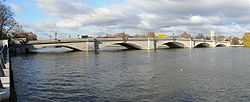Putney Bridge
| Putney Bridge | |
|---|---|
 | |
| Carries | A219 road |
| Crosses | River Thames |
| Locale | London, England |
| Design | Arch bridge |
| Opened | 1729/1886 |
| Heritage status | Grade II listed structure |
Putney Bridge is a bridge crossing of the River Thames in west London, linking Putney on the south side with Fulham to the north. Putney Bridge tube station is located near the north side of the bridge.
History
First bridge

One story runs that "in 1720 Sir Robert Walpole was returning from seeing George I at Kingston and being in a hurry to get to the House of Commons rode together with his servant to Putney to take the ferry across to Fulham. The ferry boat was on the opposite side, however and the waterman, who was drinking in the Swan, ignored the calls of Sir Robert and his servant and they were obliged to take another route. Walpole vowed that a bridge would replace the ferry."[1]
The Prince of Wales apparently "was often inconvenienced by the ferry when returning from hunting in Richmond Park and asked Walpole to use his influence by supporting the bridge."[citation needed]
Construction of a bridge was first sanctioned by an Act of Parliament in 1726. Built by local master carpenter Thomas Phillips to a design by architect Sir Jacob Acworth, the first bridge was opened in November 1729, to become the only bridge between London Bridge and Kingston Bridge at the time. A toll bridge, it featured tollbooths at either end of the timber-built structure.[2]
In October 1795, Mary Wollstonecraft allegedly planned to commit suicide by jumping from the bridge, because she had returned from a trip to Sweden to discover that her lover was involved with an actress from London.<ref name = Wardle"> Wardle, Ralph. M. ed, Collected Letters of Mary Wollstonecraft, 1979, p.317</ref>
In 1845, the bridge was specified as the starting point of the revised course for the annual Oxford - Cambridge University Boat Race.
The bridge was badly damaged by the collision of a river barge in 1870. Although part of the bridge was subsequently replaced, soon the entire bridge would be demolished, and in 1886 was replaced by the stone bridge that stands today.
Current bridge

The Metropolitan Board of Works purchased the bridge in 1879, discontinued the tolls in 1880, and set about its replacement. The current bridge was designed by civil engineer Sir Joseph Bazalgette as a five-span structure, built of stone and Cornish granite (Bazalgette also designed London's sewerage system, and the bridge forms part of this system). It was constructed by John Waddell of Edinburgh, whose tender of £240,433 was accepted on 15 April 1882. It is some 700 ft long (210 m) and 43 ft wide (13 m), and was opened by the Prince (later King Edward VII) and Princess of Wales on 29 May 1886.[2]
Putney Bridge is the only bridge in Britain to have a church at both ends[citation needed]: St. Mary's Church, Putney is located on the south and All Saints Church, Fulham on the north bank.
The stone marking the downstream end of the Championship Course still used by the Boat Race, Wingfield Sculls and several major head races is now just upstream of the current bridge, but the bridge is still often incorrectly said to be the start of the Boat Race course.[citation needed]
Putney Bridge is often very busy on Saturdays, when Fulham F.C. are playing at home, as this is the main way for fans to cross the river.
In March 1953, British serial killer and necrophiliac John Christie was finally arrested on Putney Bridge.
In 2007, the Grade 2 listed structure[3] suffered considerable damage by a developer who cut several holes into the Cornish Granite of the southern approach of the bridge[4]

In popular culture
In the final scene of the 1998 movie Lock, Stock and Two Smoking Barrels, Tom is on Putney Bridge about to throw two very valuable shotguns in the river, while his friends try to call him.
See also
- Crossings of the River Thames
References
External links
| Wikimedia Commons has media related to Putney Bridge. |
| ||||||||
| ||||||||||||||||||||||
Coordinates: 51°28′00″N 0°12′48″W / 51.46665°N 0.21339°W
